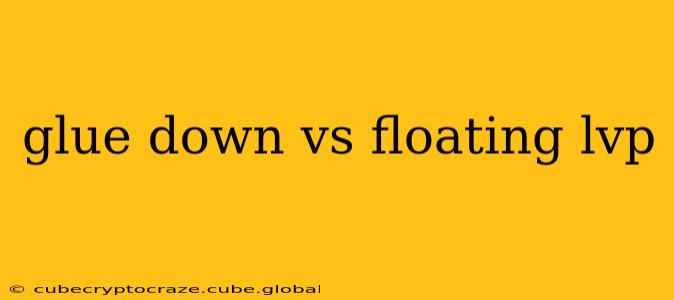Luxury vinyl plank (LVP) flooring has exploded in popularity, offering a durable, waterproof, and stylish alternative to traditional hardwood and tile. But when it comes to installation, you'll face a crucial decision: glue-down or floating? Both methods offer distinct advantages and disadvantages, and the best choice depends entirely on your specific needs and circumstances. This comprehensive guide will explore the key differences, helping you make the informed decision for your home.
What is Glue-Down LVP?
Glue-down LVP installation involves adhering each plank directly to the subfloor using a specialized adhesive. This creates a permanent bond, resulting in a solid, stable floor with minimal movement.
Advantages of Glue-Down LVP:
- Superior Durability and Stability: Glue-down LVP offers exceptional stability and resistance to indentations and damage, making it ideal for high-traffic areas.
- Water Resistance: While all LVP is waterproof (meaning it won't absorb water), the solid bond created by glue-down installation enhances its water resistance, especially against standing water.
- Quieter Floor: The solid connection to the subfloor minimizes sound transmission, resulting in a quieter floor compared to floating installations.
- Seamless Appearance: Glue-down LVP tends to create a more seamless, integrated look, minimizing the appearance of seams between planks.
Disadvantages of Glue-Down LVP:
- More Difficult Installation: Glue-down installation is more complex and time-consuming than floating, often requiring professional installation.
- Permanent Installation: Once glued, the flooring is permanently affixed to the subfloor, making removal and replacement significantly more challenging and costly.
- Subfloor Preparation: The subfloor must be perfectly level and smooth for a successful glue-down installation; any imperfections will show through.
What is Floating LVP?
Floating LVP installation involves laying the planks without adhesive, allowing them to “float” on top of the subfloor. These planks typically utilize a click-lock or drop-lock system for easy connection.
Advantages of Floating LVP:
- Easier Installation: Floating LVP is significantly easier to install than glue-down, making it a DIY-friendly option.
- Removable and Reusable: Floating LVP can be easily removed and, in many cases, reused, offering flexibility if you decide to redecorate or move.
- Subfloor Tolerance: Floating LVP is more forgiving of minor subfloor imperfections, reducing the need for extensive subfloor preparation.
- Sound Dampening Underlayment: The use of underlayment beneath floating LVP can significantly reduce noise and improve comfort underfoot.
Disadvantages of Floating LVP:
- Less Durable: Floating LVP is generally less durable than glue-down LVP, making it more susceptible to damage in high-traffic areas.
- More Movement and Noise: The floating installation can result in more noticeable expansion and contraction with temperature changes and more sound transmission.
- Seams More Visible: Seams are generally more noticeable in floating LVP installations compared to glue-down.
- Potential Moisture Issues (with improper underlayment): While LVP itself is waterproof, the wrong underlayment can trap moisture under the planks.
Which type of LVP is best for kitchens and bathrooms?
Both glue-down and floating LVP are suitable for kitchens and bathrooms, provided the correct installation methods and precautions are taken. Glue-down is often preferred in these high-moisture areas due to its superior water resistance and enhanced durability. However, if proper waterproof underlayment is used, floating LVP can also be a suitable option.
How much does each installation method cost?
The cost of LVP installation varies significantly depending on factors like the size of the area, the type of LVP, the cost of labor (if hiring a professional), and the condition of the subfloor. Generally, glue-down LVP installation tends to be more expensive due to the higher labor costs associated with a more complex installation.
Can I install LVP over existing tile?
Installing LVP over existing tile is possible, but requires careful consideration. Both glue-down and floating methods can be used, but proper preparation is critical. The tile must be firmly adhered to the subfloor, and any cracks or loose tiles should be repaired. An appropriate underlayment may be necessary to level the surface and ensure a stable base.
Can I install LVP myself?
Floating LVP is generally considered a DIY-friendly option, while glue-down installation is best left to professionals due to the complexity of the process and the need for precision.
By weighing the pros and cons of each installation method and considering your specific needs and circumstances, you can confidently choose the best option for your home. Remember to always prioritize proper subfloor preparation regardless of the installation method you choose.
